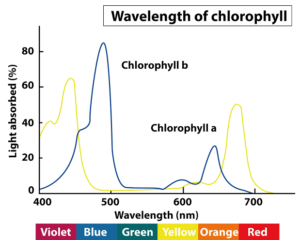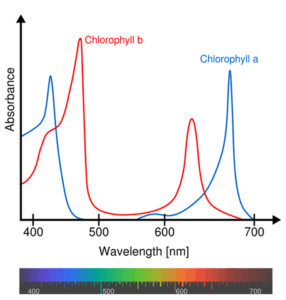Back to: Botany 400 Level
My brilliant Afrilearn scholar, welcome back! I hope you’re doing well and ready to take on another exciting lesson! Have you ever wondered what makes plants green and why they need sunlight? Today, we’re going to talk about Chlorophyll and Light Absorption—two key players in the process that allows plants to make their own food and grow strong. By the end of this lesson, you’ll understand how chlorophyll helps plants capture light and convert it into energy.
Chlorophyll and light absorption
Think about how you feel when you step outside on a sunny day. The warmth of the sun gives you energy, and you feel more alive! Well, plants feel the same way. They need sunlight to survive and grow, but instead of soaking up the sun like we do, they use chlorophyll—the green pigment in their leaves—to trap sunlight and convert it into food. This process is called photosynthesis, and it’s how plants feed themselves. Today, we’ll focus on how chlorophyll works to absorb light and why it’s so important for plants.

What is Chlorophyll?
Chlorophyll is a green pigment found in the chloroplasts of plant cells. It’s what gives plants their green colour and plays a critical role in photosynthesis. Chlorophyll absorbs light energy from the sun and converts it into chemical energy, which the plant uses to produce glucose (sugar) from carbon dioxide and water.
There are two main types of chlorophyll:
Chlorophyll a: This is the primary pigment involved in photosynthesis.
Chlorophyll b: This pigment helps chlorophyll a by capturing additional light energy, especially in the blue and red parts of the spectrum.
How Does Chlorophyll Absorb Light?
Chlorophyll absorbs light most efficiently in the blue and red parts of the light spectrum, but it reflects green light, which is why plants look green to us. The absorption of light happens in the chloroplasts, specifically in the thylakoid membranes.
When chlorophyll absorbs light energy, it excites electrons in the chlorophyll molecule. These high-energy electrons are passed through a series of reactions, eventually leading to the production of ATP (energy) and NADPH (another energy carrier). These energy molecules are essential for the next stage of photosynthesis, where carbon dioxide is converted into glucose.
The Importance of Chlorophyll in Photosynthesis
Without chlorophyll, plants wouldn’t be able to capture light energy, and photosynthesis wouldn’t happen. Photosynthesis is the foundation of life on Earth—it produces the oxygen we breathe and the food that all living creatures, including humans, depend on.
Photosynthesis Process
Light Absorption: Chlorophyll absorbs sunlight.
Energy Conversion: The light energy is used to make ATP and NADPH.
Glucose Production: ATP and NADPH help convert carbon dioxide and water into glucose (C₆H₁₂O₆) and oxygen (O₂).
Think of chlorophyll like a solar panel. Just as a solar panel captures sunlight and turns it into electricity to power a house, chlorophyll captures sunlight and turns it into chemical energy to power the plant. The plant then uses this energy to produce glucose, which is its food. This food is what helps the plant grow, produce flowers, and even make seeds.
Have you ever noticed how the leaves of plants in the shade often look different from those in the sun? That’s because the shaded leaves don’t receive enough sunlight, and they produce less chlorophyll, which is why they may appear lighter in colour. In contrast, the leaves exposed to more sunlight are darker and healthier.

Why Do Plants Need Light?
Plants use light to make food through photosynthesis. This food is not only used for growth but also stored in the plant for later use. Without enough light, plants cannot produce enough energy to survive.
Light Intensity and Plant Growth
In a bright sunny area, plants can make a lot of food and grow tall and healthy.
In a low-light area, plants will produce less food, and their growth may be stunted.
Summary
Chlorophyll is a green pigment in plant cells that absorbs light energy and plays a key role in photosynthesis. By capturing light, chlorophyll helps plants convert sunlight into chemical energy, which is used to produce glucose for growth. Without chlorophyll, plants wouldn’t be able to make their own food, and life on Earth would not be the same.
Evaluation
- What is the role of chlorophyll in photosynthesis?
- How does chlorophyll help plants absorb light?
- Why do plants appear green to us?
- What would happen if plants didn’t have chlorophyll?
Keep up the fantastic work, my scholar! You’re getting closer to mastering plant physiology. Remember, just as plants rely on sunlight to grow, you can rely on your growing knowledge to succeed! Keep feeding your mind with the energy of learning. I can’t wait to see you in the next lesson—keep shining!
